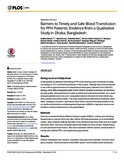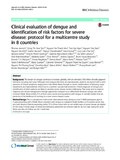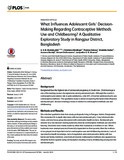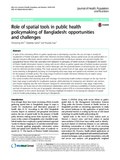Journal Articles (2016)
Browse by
Recent Submissions
-
Barriers to timely and safe blood transfusion for PPH patients: evidence from a qualitative study in Dhaka, Bangladesh
(BRAC Univeristy, 2016-12-02)Background and Objectives In Bangladesh, postpartum hemorrhage (PPH) is the leading cause of maternal mortality accounting for 31% of all blood transfusions in the country. Although safe blood transfusion is one of the 8 ... -
Clinical evaluation of dengue and identification of risk factors for severe disease: protocol for a multicentre study in 8 countries
(© 2016 BMC Infectious Diseases, 2016-02-18)Background The burden of dengue continues to increase globally, with an estimated 100 million clinically apparent infections occurring each year. Although most dengue infections are asymptomatic, patients can present with ... -
The global burden of women's cancers: a grand challenge in global health
(© 2017 The Lancet, 2017-02-25)Every year, more than 2 million women worldwide are diagnosed with breast or cervical cancer, yet where a woman lives, her socioeconomic status, and agency largely determines whether she will develop one of these cancers ... -
Double trouble: prevalence and factors associated with tuberculosis and diabetes comorbidity in Bangladesh
(BRAC Univeristy, 2016-10-31)Background Diabetes among tuberculosis patients increases the risk of tuberculosis treatment failure, death, and development of multidrug-resistant tuberculosis. Yet, there is no data is available in Bangladesh on the ... -
Trends and determinants of inequities in childhood stunting in Bangladesh from 1996/7 to 2014
(© 2016 International Journal for Equity in Health, 2016-11-16)Background We explore long-term trends and determinants of socioeconomic inequities in chronic childhood undernutrition measured by stunting among under-five children in Bangladesh. Given that one in three children remain ... -
What influences adolescent girls’ decision-making regarding contraceptive methods use and childbearing? a qualitative exploratory study in Rangpur district, Bangladesh
(© 2016 Plos One, 2016-06-23)Background: Bangladesh has the highest rate of adolescent pregnancy in South Asia. Child marriage is one of the leading causes of pregnancies among adolescent girls. Although the country's contraceptive prevalence rate is ... -
Cross-country analysis of strategies for achieving progress towards global goals for women’s and children’s health
(© Bulletin of the World Health Organization 2016, 2016-02-21)OBJECTIVE: To identify how 10 low- and middle-income countries achieved accelerated progress, ahead of comparable countries, towards meeting millennium development goals 4 and 5A to reduce child and maternal ... -
Role of spatial tools in public health policymaking of Bangladesh: opportunities and challenges
(© 2016 Journal of Health, Population and Nutrition, 2016-02)In spite of the increasing efforts to gather spatial data in developing countries, the use of maps is mostly for visualization of health indicators rather than informed decision-making. Various spatial tools can aid ... -
Health impact of climate change in Bangladesh: a summary
(© 2016 Current Urban Studies, 2016)Bangladesh, one of the South Asian countries, has started experiencing major public health impacts of climate change due to its vulnerable geographical location. The objective of this paper is to look at the extent of ... -
Career preferences of final year medical students at a medical school in Kenya – a cross sectional study
(© 2016 BMC Medical Education, 2016-01)Background The World Health Organization (WHO) recommended physician to population ratio is 23:10,000. Kenya has a physician to population ratio of 1.8:10,000 and is among 57 countries listed as having a serious shortage ...






